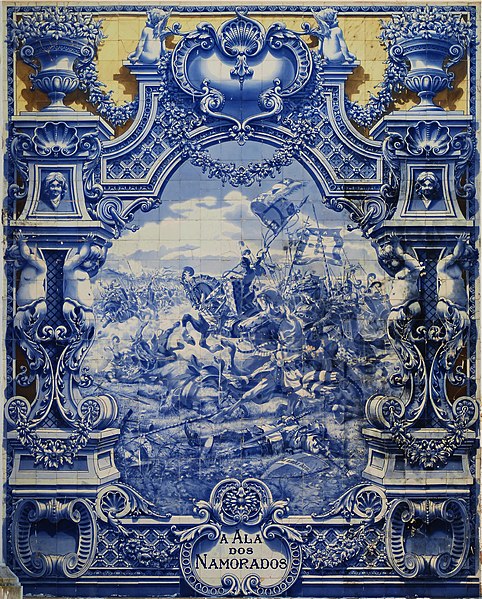Azulejo is a form of Portuguese and Spanish painted tin-glazed ceramic tilework. Azulejos are found on the interior and exterior of churches, palaces, ordinary houses, schools, and nowadays, restaurants, bars and even railways or subway stations. They are an ornamental art form, but also had a specific functional capacity like temperature control in homes.
Panel of the Battle of Aljubarrota by Portuguese artist Jorge Colaço, 1922
(Moorish) Alicatado (ca. 13th century) in the Cuarto Real de Santo Domingo, Granada
(Moorish) Alicatado in the Alhambra (14th century), Granada
(Christian) Capilla de San Bartolomé (ca. 1410), Córdoba
Zellij is a style of mosaic tilework made from individually hand-chiseled tile pieces. The pieces were typically of different colours and fitted together to form various patterns on the basis of tessellations, most notably elaborate Islamic geometric motifs such as radiating star patterns. This form of Islamic art is one of the main characteristics of architecture in the western Islamic world. It is found in the architecture of Morocco, the architecture of Algeria, early Islamic sites in Tunisia, and in the historic monuments of al-Andalus. From the 14th century onwards, zellij became a standard decorative element along lower walls, in fountains and pools, on minarets, and for the paving of floors.
A wall covered in zellīj at the Ben Youssef Madrasa in Marrakesh
Tile decoration on the upper part of the minaret of the Kasbah Mosque in Marrakesh (modern restoration of original 12th-century tiles)
Zellij panel with complex geometry and mosaic-formed Arabic letters in the Mirador de Lindaraja in the Alhambra (14th century)
Zellij remains in Chellah (14th century), in bright colours and floral motifs that may have been a hallmark of craftsmen from Tlemcen








